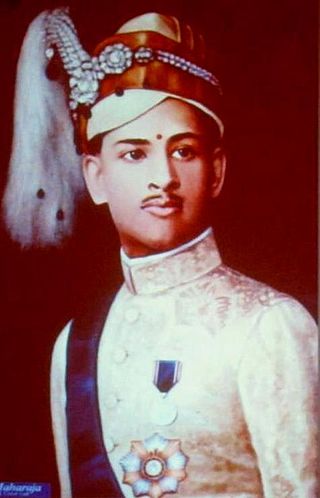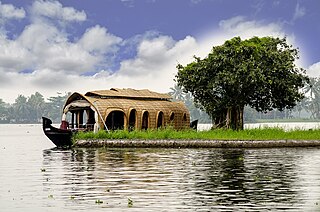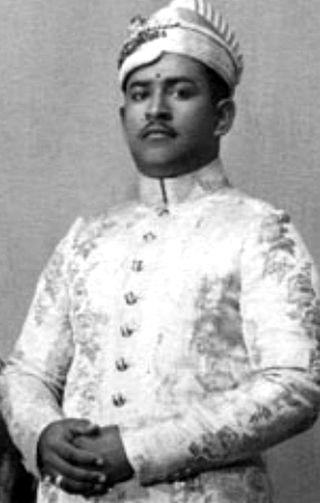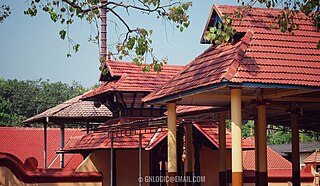
The Kingdom of Travancore, also known as the Kingdom of Thiruvithamkoor or later as Travancore State, was an Indian kingdom that lasted from c. 1729 until 1949. It was ruled by the Travancore Royal Family from Padmanabhapuram, and later Thiruvananthapuram. At its zenith, the kingdom covered most of the south of modern-day Kerala and the southernmost part of modern-day Tamil Nadu with the Thachudaya Kaimal's enclave of Irinjalakuda Koodalmanikyam temple in the neighbouring Kingdom of Cochin. However Tangasseri area of Kollam city and Anchuthengu near Attingal in Thiruvananthapuram were parts of British India.

Sree Padmanabhadasa Sree Chithira Thirunal Balarama Varma, popularly known as Sree Chithira Thirunal, was the last ruling Maharaja of the Indian princely state of Travancore, in southern India until 1949 and later the Titular Maharajah of Travancore until 1991. His reign is known for several notable reforms that have indelible impact on the society and culture of Kerala.

Anizham Thirunal Marthanda Varma was the founding monarch of the southern Indian Kingdom of Travancore from 1729 until his death in 1758. He was succeeded by Rama Varma (1758–98). While he was the heir to the throne, he suggested to his uncle the idea of forming an alliance with the Mughal Nawab of Carnatic. Rama Varma pledged allegiance to the Mughal empire and embraced the title of "Zamindar of Malabar". The feudatory status of Travancore persisted even during the era of Hyder Ali.
Cherthala, IPA:[t͡ʃeːrt̪ːɐlɐ], is a Municipal town and a Taluk located at National highway 66 in the district of Alappuzha, in the state of Kerala, India. Cherthala is the satellite town and industrial hub of Kochi.

Ārāttu is an annual ritual performed during Hindu temple festivals in Kerala, India, in which a priest bathe the idol of a deity by dipping it in a river or a temple tank. It is mainly carried out at the end of a temple festival. Ārāttu is celebrated twice annually—the spring festival and the autumn festival. A festival normally lasts 10 days.

Thiruvananthapuram District is the southernmost district in the Indian state of Kerala. The district was created in 1949, with its headquarters in the city of Thiruvananthapuram, which is also Kerala's administrative centre. The present district was created in 1956 by separating the four southernmost Taluks of the erstwhile district to form Kanyakumari district. The city of Thiruvananthapuram is also known as the Information technology capital of the State, since it is home to the first and largest IT park in India, Technopark, established in 1990. The district is home to more than 9% of total population of the state.

The Padmanabhaswamy Temple is a Hindu temple, dedicated to Vishnu, in Thiruvananthapuram, the capital of the state of Kerala, India. It is one of the 108 Divya Desams, the sacred abodes of Vishnu in the Sri Vaishnava tradition. It is widely considered as the world's richest Hindu temple. The name of the city of 'Thiruvananthapuram' in Malayalam and Tamil translates to "The City of Ananta". The temple is built in an intricate fusion of the Kerala style and the Dravidian style of architecture, featuring high walls, and a 16th-century gopuram. While as per some traditions the Ananthapura temple in Kumbla in Kasaragod district in Kerala is considered as the original spiritual seat of the deity ("Mulasthanam"), architecturally to some extent, the temple is a replica of the Adikesava Perumal temple in Thiruvattar in Kanyakumari district in Tamil Nadu.

The Adikesava Perumal Temple is a Hindu temple located in Thiruvattar, Kanyakumari district, Tamil Nadu, India and is one of the 108 Divya desams, the holy sites of Hindu Vaishnavism according to existing Tamil hymns from the seventh and eighth centuries C.E. The temple is one of the historic thirteen Divya Deshams of Malai Nadu. The temple is a picturesque setting surrounded on three sides by rivers namely, It was the Rajya Temple and Bharadevatha shrine of Erstwhile Travancore. After state reorganisation, the temple handed over to Tamilnadu H&RCE Dept. The presiding Vishnu in the form of Ananthapadmabhan/Adikeshavaperumal is believed to be older than Padmanabhaswamy Temple in Thiruvananthapuram. Since Vishnu resides here in a reclining position, and is surrounded by rivers, the temple is called as "The Srirangam of Chera Kingdom".

Alappuzha, also known as Alleppey, is the administrative headquarters of Alappuzha district in the state of Kerala, India. The backwaters of Alappuzha are one of the most popular tourist attractions in India which attracts millions of domestic and international tourists.

Chengannur is a municipality and Town in Alappuzha district, Kerala, India. It is also the headquarters of the Chengannur Taluk. Chengannur is located in the south-eastern part of the district, in the region known as Odanad, along the banks of Pamba River. Chengannur is 36 kilometres (22 mi) southeast of the district headquarters Alappuzha and 117 kilometres (73 mi) north of the state capital Thiruvananthapuram. Both the NH 183 and Main Central Road pass through the town.
The history of Thiruvananthapuram dates back to the 18th century AD. In 1795, the city became the capital of the princely state of Travancore. Several historic landmarks of the city, including the Kowdiar Palace, University of Kerala, and Napier Museum were built during that period. After independence, Thiruvananthapuram was made the capital of the state of Kerala.
The Ettara Yogam or the King and Council of Eight and a half has been the administrative setup of Sri Padmanabhaswamy Temple, Thiruvananthapuram, Kerala, India, for centuries.

Sree Padmanabhadasa Sree Uthradom Thirunal Marthanda Varma was the titular Maharaja of Travancore. He was the younger brother of the last ruling monarch of the Kingdom of Travancore, Maharajah Chithira Thirunal Balarama Varma.

Thrikkovil Sree Padmanabhaswamy temple is a Hindu temple with Lord Vishnu as the presiding deity, located at Vallicode village in Pathanamthitta District in Kerala, India.

The Travancore royal family was the ruling house of the Kingdom of Travancore.The Travancore royal family signed a treaty with the British in 1788, thereby adopting British dominance. Later, in 1805, they revised the treaty, leading to a diminution of royal authority and the loss of political independence for Travancore. They had to give up their ruling rights over the common people in 1949 when Travancore were forced to merge with Independent India and their political pension privileges were abolished in 1971.
Vettikkavala is a village located in the Kollam district in the state of Kerala, India. One point of interest within the village is a Shiva-Vishnu temple which hosts a special deity called Vathukkal Njali Kunju. An annual celebration of Pongala is held at the temple. The village is also well known for temple arts and a palace constructed by Sree Moolam Thirunal.

The Pazhavangadi Maha Ganapathy temple(Malayalam: ശ്രീ പഴവങ്ങാടി മഹാ ഗണപതി ക്ഷേത്രം) is situated at East Fort in the heart of Thiruvananthapuram City, Kerala, India. The main Deity of the temple is Sri Mahaganapathy (Ganesha). The main idol is installed in a seated posture with the right leg in a folded stance. The temple is situated in close proximity to the Sri Padmanabhaswamy temple. Other Deities worshiped at the temple include Dharmasasta, Goddess Durga and Nagaraja. The temple sculptures include 32 different forms of Lord Ganesha.
The Mithrananthapuram Trimurti Temple is a Hindu temple complex in Thiruvananthapuram, Kerala, India. It is a temple in where devotees get to offer worship to all the three Trimurti deities, namely,. The Temple is located on the western side of Padmanabhaswamy temple in Thiruvananthapuram.

The Sree Subrahmanya Swamy Temple (Perumthrikkovil), also known as Kerala Palani or Dakshina Palani (lit. 'Southern Palani'), in Haripad, Kerala, is one of the oldest and largest temples in the region. According to belief, the temple predates the beginning of Kali Yuga. This temple holds the distinction of being the largest Subrahmanya Swami Temple in Kerala, and features the longest golden flagpost, known as the dhwajastambha (kodimaram in Malayalam). The temple's main deity is believed to embody not only Subrahmanya Swamy but also Lord Shiva and Lord Vishnu, making it a highly revered and powerful place of worship.

Amunthirathu Devi Temple is a Hindu temple dedicated to Goddess Sree Bhadra Kali located in Thiruvananthapuram, India. The temple is situated at Mudakkal, around 8 km north of Attingal in the Thiruvananthapuram district of Kerala. The temple enshrines a Krishna shila idol of the goddess Amunthirathamma, an incarnation of Bhadra Kali. Devi is in Ardha padmasana, Andarmugha and chathur bahu.















